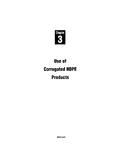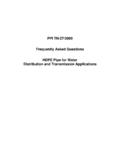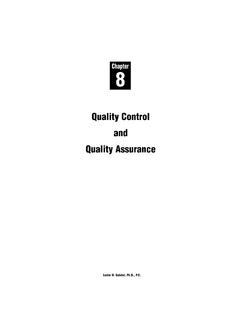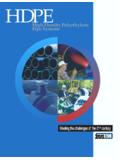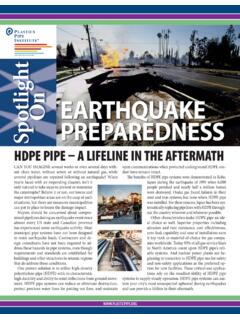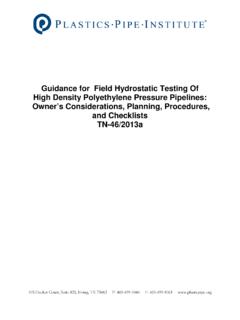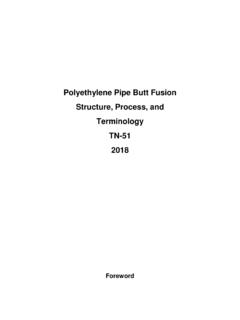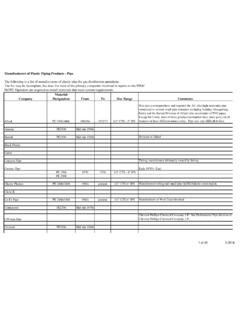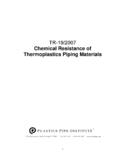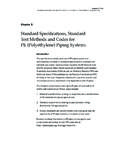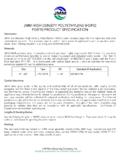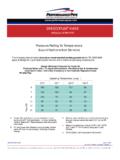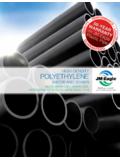Transcription of PE 4710 Mitered Elbow Finite Element Analysis
1 GTI PROJECT NUMBER PE 4710 Mitered Elbow Finite Element Analysis Date Submitted: April 5, 2016 Revised: April 11, 2016 Project Investors: PPI GTI Project Manager: Natalya Bates Project Manager 847-768-0953 GTI Principal Investigators: Ernest Lever Senior Institute Engineer 847-768-3415 Oren Lever Principal Engineer 847-768-0668 Gas Technology Institute 1700 S. Mount Prospect Rd. Des Plaines, Illinois 60018 FINAL REPORT Page ii Legal Notice This information was prepared by Gas Technology Institute ( GTI ) for Plastics Pipe Institute (PPI). Neither GTI, the members of GTI, the Sponsor(s), nor any person acting on behalf of any of them: a. Makes any warranty or representation, express or implied with respect to the accuracy, completeness, or usefulness of the information contained in this report, or that the use of any information, apparatus, method, or process disclosed in this report may not infringe privately-owned rights.
2 Inasmuch as this project is experimental in nature, the technical information, results, or conclusions cannot be predicted. Conclusions and Analysis of results by GTI represent GTI's opinion based on inferences from measurements and empirical relationships, which inferences and assumptions are not infallible, and with respect to which competent specialists may differ. b. Assumes any liability with respect to the use of, or for any and all damages resulting from the use of, any information, apparatus, method, or process disclosed in this report; any other use of, or reliance on, this report by any third party is at the third party's sole risk. c. The results within this report relate only to the items tested Page iii Table of Contents Legal Notice .. ii Table of Contents .. iii Table of Figures .. iv List of Tables .. vi List of Acronyms.
3 Vi Executive Summary .. 7 Parametric Geometry Model .. 10 Finite Element Analysis Model .. 13 Material Constitutive Model .. 16 Significance of Pipe Diameter .. 17 Comparison of Internally and Externally Reinforced Elbow Stresses .. 18 Design of Experiment .. 23 FEA Results .. 23 Effect of Bend Radius on Elbow Stress .. 30 Fusion Beads .. 36 Mesh Quality .. 40 Reference Stress for Calculations .. 41 Comparison of FEA results to ASME Design Equations for Mitered Elbows .. 42 Response Surface Evaluation .. 59 Future Work .. 59 Bibliography .. 59 Page iv Table of Figures Figure 1. Quarter model of 90 , constant ID, 5-segment miter-bend for FEA .. 11 Figure 2. Quarter model of 90 , constant OD, 3-segment miter-bend for FEA .. 11 Figure 3. Quarter model configuration .. 12 Figure 4. Symmetry surfaces .. 13 Figure 5. Pressure surfaces.
4 14 Figure 6. Typical 14 Figure 7. Typical mesh, joint detail .. 15 Figure 8. Probe locations .. 15 Figure 9. HDPE stress-strain curves, engineering strain rate .. 16 Figure 10. Comparison of stresses in ID and OD reinforced elbows .. 18 Figure 11. Comparison of OD and ID reinforced elbows, by maximum von Mises stress at intrados .. 19 Figure 12. Comparison of OD and ID reinforced elbows, by maximum first principal stress at intrados .. 20 Figure 13. Comparison of OD and ID reinforced elbows, by average von Mises stress at intrados .. 21 Figure 14. Comparison of OD and ID reinforced elbows, by average first principal stress at intrados .. 22 Figure 15. 3-segment bend, BRF= , 1st, 2nd and 3rd principal stresses [psi] (left to right), external view, full model .. 23 Figure 16. 3-segment bend, BRF= , 1st principal (hoop) stress [psi], external view, joint .. 24 Figure 17. 3-segment bend, BRF= , 1st, 2nd and 3rd principal stresses [psi] (left to right), internal view, full model.
5 25 Figure 18. 3-segment bend, BRF= , 1st principal (hoop) stress [psi], internal view, joint .. 26 Figure 19. 3-segment bend, BRF= , von Mises stress [psi], full model .. 27 Figure 20. 5-segment bend, BRF= , 1st, 2nd and 3rd principal stresses [psi] (left to right), external view, full model .. 28 Figure 21. 5-segment bend, BRF= , 1st, 2nd and 3rd principal stresses [psi] (left to right), internal view, full model .. 29 Figure 22. Effect of bend radius on externally reinforced Elbow stress top left, top right, bottom right, bottom left .. 31 Figure 23. Effect of bend radius on internally reinforced Elbow stress top left, top right, bottom right, bottom left .. 31 Figure 24. Probe paths (blue highlights) at intrados and extrados, as used in Figure 25 through Figure 27 .. 32 Figure 25. First Principal stress along intrados and extrados paths, at different bend radii, GSR=.
6 33 Figure 26. First Principal stress along intrados and extrados paths, at different bend radii, GSR= .. 34 Figure 27. First Principal stress along intrados path, at different bend radii, GSR= vs. GSR= .. 35 Page v Figure 28. 3-segment bend, 1st principal (hoop) stress [psi], internal view, joint with bead .. 36 Figure 29. 3-segment bend, extrados hoop stress [psi], internal view close-up, joint with bead .. 37 Figure 30. 3-segment bend, intrados hoop stress [psi], internal view close-up, joint with bead .. 37 Figure 31. Comparison of hoop stress [psi] on model with and without beads, full model .. 38 Figure 32. Comparison of hoop stress [psi] on model with and without beads, extrados .. 39 Figure 33. Comparison of hoop stress [psi] on model with and without beads, intrados .. 39 Figure 34. Mesh quality check .. 40 Figure 35.
7 Relative Values of First Principal Stress at Various Geometric Locations .. 41 Figure 36. Fit of FEA results to Equation 5 to determine parameter a , for BRF>= .. 44 Figure 37. 95% Prediction surfaces for FEA model fit, for BRF>= .. 45 Figure 38. GSR versus Pipe DR for different miter angles with BRF>= , from Table 3.. 48 Figure 39. Plot of a versus BRF, with illustrative curve fit and 99% prediction bounds .. 49 Figure 40. Fit of BRF=1 FEA results to Equation 5 to determine parameter a .. 50 Figure 41. 95% Prediction surfaces for BRF=1 FEA model fit .. 51 Figure 42. GSR versus Pipe DR for different miter angles, from Table 3 (BRF>= ) and Table 4 (BRF=1). 53 Figure 43. GSR comparison when a= versus a= .. 54 Figure 44. Mitered Elbow configuration for calculations .. 55 Figure 45. Equations and parameter values used in calculations .. 56 Figure 46. Comparison of ASME Elbow design equations with bend radius set to x pipe outside diameter and a=.
8 57 Figure 47. Percent difference between ASME , equations 4a and 4b with bend radius set to x pipe outside diameter and a= (relative to eq. 4a).. 58 Figure 48. Percent difference between ASME , equations 4a and 4b with bend radius set to x pipe outside diameter and a= (relative to eq. 4a) .. 58 Page vi List of Tables Table 1. Average hoop stress (psi) at miter joint, SDR 17, Gore-DR (Pipe DR 17 * GSR ), .. 17 Table 2. Comparison of stresses in ID and OD reinforced Mitered elbows .. 18 Table 3. Calculated GSR values (BRF>= ), a= .. 47 Table 4. Calculated GSR values (BRF=1), a= .. 52 List of Acronyms ASTM American Society for Testing and Materials BRF Bend Radius Factor (BRF x OD = Bend Radius) CAD Computer Aided Design DoE Design of Experiment FEA Finite Element Analysis FEM Finite Element Method GTI Gas Technology Institute HDPE High Density Polyethylene ID Inner Diameter OD Outer Diameter PPI Plastics Pipe Institute RSM Response Surface Methodology SDR Standard Dimension Ratio GSR Geometric Strength Ratio DR Dimension Ratio Page 7 Executive Summary A series of 357 nonlinear Finite Element analyses was conducted to evaluate the performance of various configurations of fabricated PE 4710 elbows.
9 In order to understand how a particular design behaves it is necessary to conduct a large number of analyses that capture the range of boundary conditions and material properties. The approach taken in the study was to use a Virtual Design of Experiment (DoE). In this approach each Finite Element Analysis (FEA) is viewed as a virtual experiment. Preliminary Analysis showed that the following six input parameters are sufficient to fully understand the performance characteristics of a Mitered Elbow : 1. Dimension Ratio - DR 2. Miter Angle - Angle 3. GSR - GSR 4. Bend Radius Factor BRF 5. Ambient Temperature - Temperature 6. Operating Pressure - Pressure A face centered cubic response surface design was chosen. Fifty (50) design points would be sufficient to fully resolve all second-order interactions of input parameters. An additional 27 design points were added to augment the design.
10 A high-quality response surface model was achieved with low standard error that is capable of properly analyzing all of the input FEA results. Appendix 0 presents the initial model information prior to actual Analysis of the results that are presented in detail in Appendices 1 through 16. In Appendix 17 we present the stress strain curves on which the analyses were based and define the stress ratio that is used in several of the analyses. Temperature dependent material properties were used to assess the impact of ambient temperature on Elbow performance. The material model used reflects the stresses developed in an Elbow upon pressurization and does not include creep of the material. This level of Analysis is sufficient as the Hydrostatic Design Stress (HDS) of the material accounts for long term creep effects for calculated stresses equal to, or lower than the HDS. The stress-strain curves were developed by detailed testing of physical test specimens of a typical PE 4710 material provided by a leading resin manufacturer.
